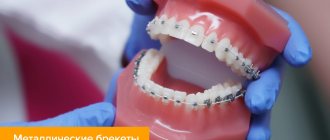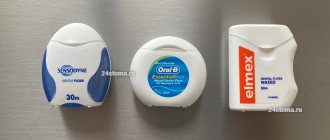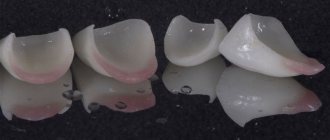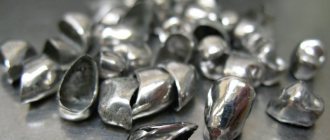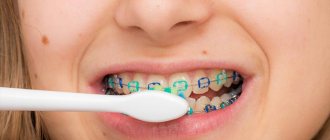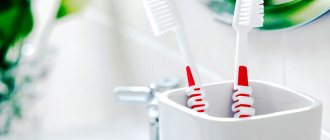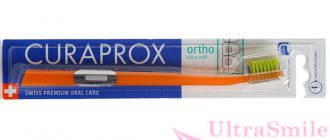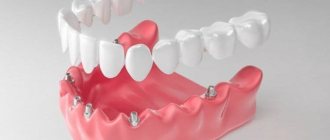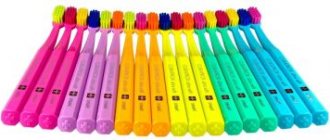Cleaning teeth only with a brush and paste is an ineffective procedure, since removing food fragments and plaque from interdental areas is a difficult task for these hygiene products.
To reduce the risk of developing caries and other inflammatory processes, it is necessary to use dental floss.
What is dental floss used for?
Floss easily copes with the difficult task of cleaning the interdental spaces. This hygiene product is especially recommended for people with crowded teeth and those undergoing treatment with braces. Timely removal of residues prevents the development of caries and gum disease. Many people believe that a toothpick is sufficient for this purpose. Dentists have a unanimous opinion on this matter: a toothpick, unlike floss, only harms the teeth.
Lanshina Natalya Viktorovna
hygienist at pediatric dentistry “Zubrenok”
The difference between dental floss and a toothpick is fundamental. Properly selected dental floss, when used correctly, removes plaque and food debris from the interdental spaces and does not injure the oral mucosa and the ligaments that hold the tooth in the bone. This is a means of dental care, prevention of caries and periodontal diseases. A toothpick is used to remove food stuck between teeth, in cavities, or under the gum. It injures the gums and ligaments of the tooth, leaving microbial plaque intact. People who use a toothpick have some kind of unresolved dental problem, a chronic disease in the oral cavity that requires emergency dental care
What are their differences?
When shopping for floss, you need to know that they are not all created equal. To achieve the best results, before purchasing them, you should decide on the type, focusing on the shape of your teeth.
There are waxed and unwaxed threads. Their difference is as follows:
- Waxed - due to their good smoothness, they can penetrate between the teeth, even if they are tightly connected to each other. The floss structure is dense. It is recommended to use waxed floss for people with dense teeth and those who have many fillings.
- Unwaxed ones clean the interdental space better. They penetrate deeper and eliminate almost all food residues. Unwaxed floss can clean most of the dental spaces without wasting a lot of material. This is achieved by peeling the thread into several thin fibers.
The thread itself has the following characteristics:
- round - designed for wide interdental openings;
- flat - necessary for people with dense teeth, that is, when there is practically no space between the teeth.
If you are faced with a choice - waxed or unwaxed thread, then remember that the second does not contain wax. The waxed one is treated with it, thanks to which it glides better and penetrates even the densest dental spaces.
The thread can be impregnated or unimpregnated. Impregnated floss is treated with special substances that, in addition to cleaning, perform other additional functions, for example, giving the mouth a fresh smell, strengthening the enamel, etc.
What dental floss is best to use?
The choice depends on the characteristics and condition of your teeth. First of all, we recommend deciding on the shape of the dental floss.
- Round floss is designed for normal and wide spaces between teeth.
- Tape floss is recommended for those who have gaps between teeth - trema and diastema.
- Flat floss is suitable for people with narrow interdental spaces.
The best dental floss is the one that is perfect for you. The health of your teeth and gums depends on the correctly chosen form. A small thread diameter will make cleaning ineffective, and a wide thread can injure the gums. If in doubt, consult your dentist about which dental floss is best for you.
Lanshina Natalya Viktorovna
hygienist at pediatric dentistry “Zubrenok”
The choice of dental floss should be individual. The hygienist or dentist knows all the nuances that need to be taken into account. Waxed and flat threads penetrate more easily into hard-to-reach places in the presence of orthopedic structures and crowded teeth. Unwaxed - better clean the contact surfaces of teeth from food debris and accumulation of bacteria. This type of floss is recommended for patients who regularly take care of their teeth, have a relatively healthy mouth, and do not have many fillings or crowded teeth. Threads that swell under the influence of saliva, as well as round cross-section, are characterized by increased atraumaticity. They clean wide interdental spaces well. Flosses are impregnated with deodorizing components and medicinal additives to fight bacteria and inflammation.
Dental floss can be made from natural material - silk (it is not very durable and is quite rare) and from artificial material, such as nylon or nylon.
How to use floss correctly
In order not to damage your teeth and especially your gums, you must use dental floss very carefully, act slowly, and be gentle with your teeth:
- Wrap about 40 cm of floss around your index/middle fingers in several layers.
- Gently grasp the floss with your thumbs and forefingers so that the distance between your hands is no more than 5 cm.
- Pull this section of the floss taut so it can easily fit between your teeth.
- Gently move the floss up and down along the tooth.
- Slowly and carefully move to the tooth line located under the gum.
- To avoid damaging your gums, use circular movements.
- Repeat the procedure for each tooth.
If this is your first time using floss to clean your teeth, there are a few important things to remember.
- First, a new piece of floss must be unwound for each tooth (under no circumstances should floss be reused).
- Secondly, be sure to treat the back of your teeth (a considerable amount of bacteria and plaque accumulates there).
- Thirdly, if you cannot hold the floss, use a special device - a flosser (usually it can be purchased at a pharmacy). If even this does not help you, be sure to contact your dentist, who will help you choose another product for additional cleaning of your teeth.
Dentists do not have a clear answer to the question of how often you should floss. However, many agree that floss can be walked along the teeth after each meal, and if the floss is impregnated with fluoride, then it is undesirable to use it more than once a day. For those with bleeding gums, it is enough to floss a couple of times a week.
As you can see, choosing dental floss is not an easy task. But, if you have an idea of what they are and how they are used depending on the existing differences, choosing the right floss becomes much easier. Take care of your teeth and visit the dentist promptly. Be healthy!
Waxed dental floss
Waxed dental floss has a smooth surface, making it easy to glide between teeth. We recommend it for those who are just starting to use dental floss: the risk of gum injury is significantly reduced. Waxed dental floss is durable, does not tear, and has a long shelf life - from 5 years. The only drawback: impregnated floss does not remove plaque very well - it is smooth and quickly slips in the interdental spaces.
What types of impregnations are there?
- Chlorhexidine - antibacterial, disinfecting effect of Curaprox DF 820.
- Herbal extracts help gums stay healthy.
- Potassium nitrate - caries prevention PresiDENT Sensitive.
- Menthol, mint - fresh breath Donfeel UF-623.
The impregnated mini-floss is convenient to carry with you - even in a handbag it does not take up much space (Donfeel Dental Floss mini-floss). The price of this thread is lower, since it is not very long.
General advantages and disadvantages
Don't be fooled by flossing: they also have disadvantages. But most often problems occur due to improper use. It is worth considering both the pros and cons:
- Cleans the interdental space that is inaccessible to a regular brush.
- Floss is easy to use; you don’t need any special skills to use it.
- Available to everyone, you can purchase it in almost any store.
- You can use it from anywhere. You don't need paste or water.
- An incorrect movement can damage the gums and create a risk of infection.
- Frequent use threatens damage to tooth enamel. This, in turn, can lead to various consequences, including caries.
The floss itself is not dangerous, but its improper use can harm your teeth. In all other cases, flosses bring only benefits. And one more thing: make sure that you are not allergic to the material from which the waxed dental floss is made.
Improper use of thread can cause bleeding
In the video, the doctor talks about the benefits and disadvantages of dental floss:
Benefits and harms
The benefits of using dental floss are as follows:
- normalization of acidity;
- reduction of plaque on tooth enamel;
- preventing the development of gum disease, caries, and stone formation;
- getting rid of bad breath from the mouth.
The use of hygiene products such as floss, toothbrush and mouthwash in combination significantly reduces the risk of dental diseases.
Improper flossing can cause a number of problems:
- mechanical damage or irritation of gum tissue;
- injury to the tongue and cheeks, which can cause the spread of infection;
- destruction of seals.
Periodic damage can lead to tooth loss.
Advantages and disadvantages of unwaxed thread
The absence of oral diseases and the presence of wide interdental spaces suggests the use of unwaxed floss to clean the dentition. During use, the unwaxed thread is divided into several separate components, which helps to expand the area of contact of the hygiene product with the surface of the chewing units.
For patients who have gaps between their teeth, dentists recommend using bulk unwaxed floss. The difference between this hygiene product is that during the cleansing process it expands and fills the wide interdental space.
A special feature of using floss is the formation of squeaking noise when cleaning. Using this sign, the patient can assess how well the cavity hygiene was carried out.
The main disadvantage of unwaxed thread is its low strength, which contributes to frequent damage to the surface of the hygiene product and a reduced service life. To clean with unwaxed floss, you must master the technique of use, since there is a high risk of damage to mucous tissue.
Contraindications for use
Despite the fact that dental floss is an excellent assistant in the matter of oral hygiene, its incorrect and thoughtless use can cause considerable harm to your teeth.
There are a number of dental ailments for which the use of floss is strictly contraindicated:
- Caries. When cleaning the interdental space with dental floss in places where there are cavities, there is a danger that a piece of the tooth may break off. If left unattended, it will continue to deteriorate due to daily friction from the floss.
- If you have crowns and bridges in your mouth, dentists recommend choosing a thread more carefully. Give preference to threads specially made for people with artificial teeth - superfloss - an invention that combines several types of threads for different types of teeth.
- Bleeding gums. Floss can injure weakened gums and introduce infection into open wounds, resulting in an inflammatory process that will require specialist intervention.
Detailed instructions for use
Those who regularly floss will confirm that cleaning between teeth is not difficult.
Carrying out this procedure does not take much time, you just need to master the technique:
- Unwind a piece 35-40 cm long from the reel (this length is enough for one procedure).
- Wrap most of it around the middle finger of one hand, and the remaining small part around the same finger on the other hand. A gap of 5-7 cm in length should remain unwound.
- To treat 1 tooth, it is enough to use a piece of only 2-3 cm. With a free finger, this piece is grabbed, stretched and carefully inserted into the gap almost to the gum.
- The floss is pressed against the surface being treated.
- Cleaning is performed in the following directions: from bottom to top on the lower jaw; to the cutting edges - on the chewing surface; from top to bottom on the upper jaw.
- Having processed one of the gaps, the segment changes. Make a turn on each finger (the used part is wound on the finger with less thread, and unwinded one turn from the other). The opposite side should be cleaned with a clean piece.
- The remaining gaps are processed using the same principle.
Tip: to achieve maximum cleansing effect, you must perform each movement at least 7 times for each tooth unit.
The video describes in more detail the correct use of interdental floss.
